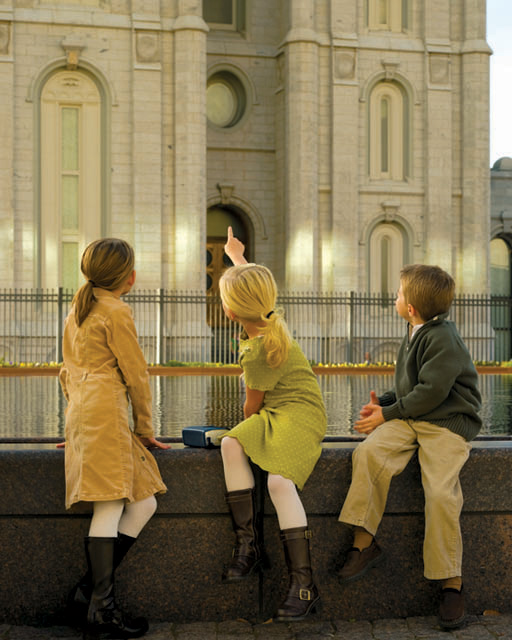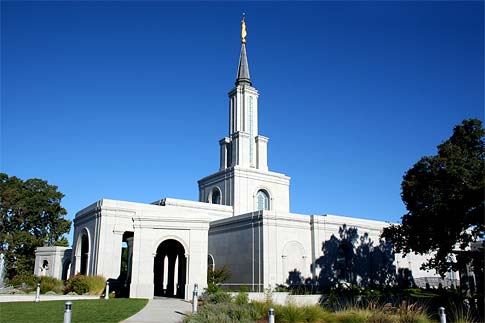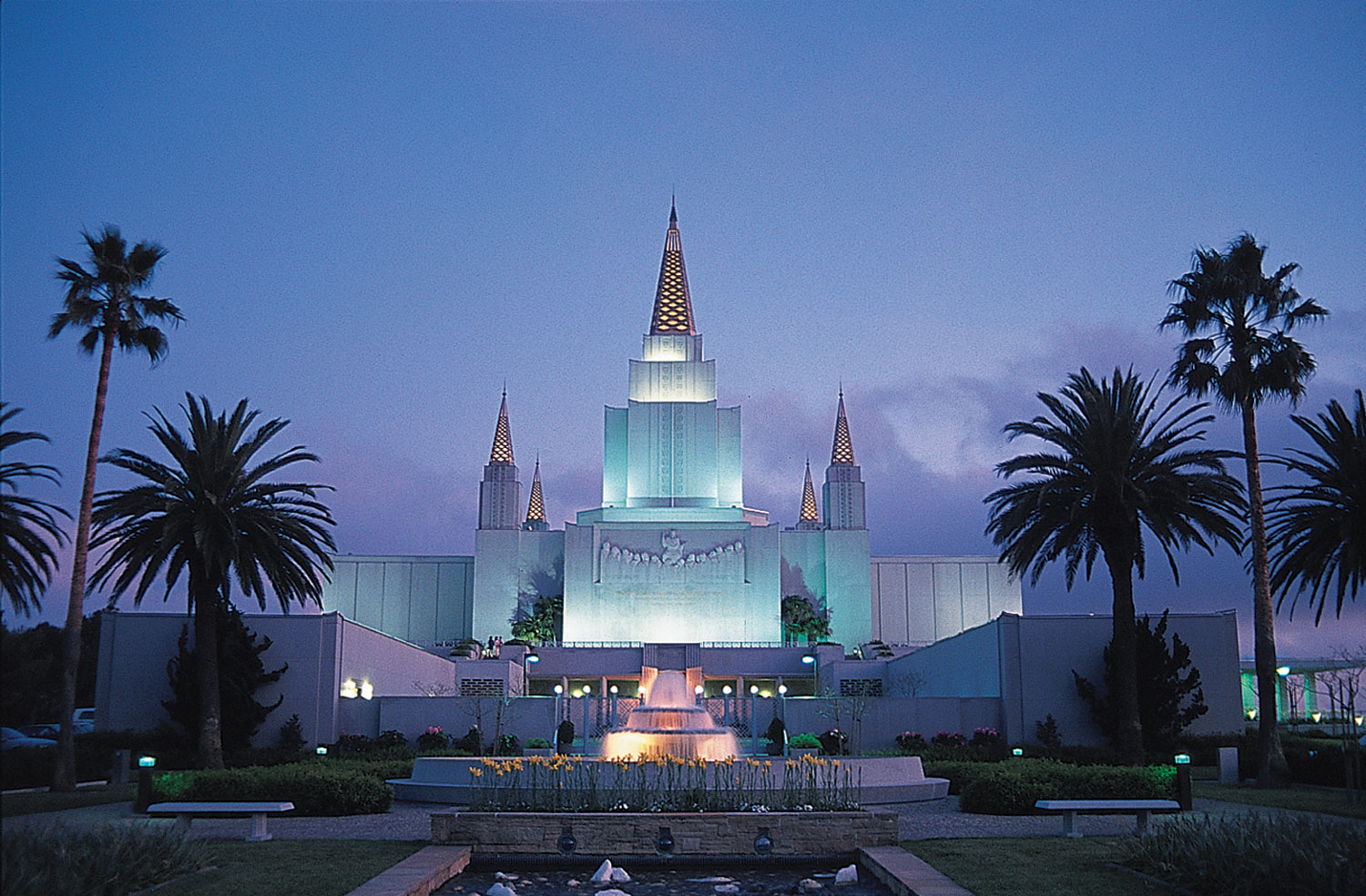Overview for the Latter-day Saint (LDS), or Mormon, Bride and Groom about their LDS Temple Wedding (Temple Sealing):
Planning a wedding is stressful and overwhelming for anyone, but the LDS girl getting married in the temple finds herself in a particularly difficult situation. Of course she doesn't need to worry about the expense of the wedding venue (getting married in an LDS Temple is free! This will help the bride and groom to have an inexpensive wedding and using the LDS Cultural Hall will help make an inexpensive wedding reception.) but the fact that the wedding will take place in and LDS temple will affect every part of her planning, from the gown to the pictures.
There are really two components to LDS temple wedding planning: spiritual and practical. Since the temple sealing involves much more than just a legal contract, it's important to be prepared spiritually to enter the temple. The temple sealing is described as the crowning ordinance of the temple in the Church of Jesus Christ of Latter-day Saints, so it's best not to wander into it unprepared. Brides who do so will find that they look back on their wedding day with mixed emotions, confusion, or even regret. Appropriate spiritual preparation for a temple sealing includes:
• Studying church-approved materials (Preparing to Enter the Holy Temple by Boyd K. Packer is excellent)
• Taking temple prep class from your branch, ward, stake, or institute
• Talking to the Bishop or parent(s) about the Temple
In any event, it will be necessary to first make an appointment with your Bishop(s) to obtain a temple recommend. Without a temple recommend that is signed by both the Bishop and the Stake President, you won't be allowed inside the temple. The best idea is to make an appointment to see the Bishop as soon as possible after the engagement. He can give prospective temple brides good advice and resources to prepare for the spiritual aspects of temple preparation. He can also help them to resolve any moral issues or problems that may prevent them from obtaining a temple recommend. After having a temple recommend interview with the Bishop, the process must be repeated with the Stake President. Both men can be busy and getting an appointment may take longer than expected, so it's better to do it sooner rather than later.
A temple recommend signifies that a member is worthy to enter the LDS Temple and receive the ordinances of endowment and sealing. The initiatory and endowment is always performed before the sealing. Some brides prefer to receive their endowments immediately before their sealing, while others like to do an endowment session a few days prior to the sealing. There is no "right" way to do it but you should know you're your initiatory will take about 30-45 minutes total time, an endowment session takes about 2 hours total time and the temple sealing lasts for about 20 minutes, so if you do it everything on the same day plan on about 3-4 hours inside the temple. Then add to that your time it takes to get ready for your sealing and wedding reception, the time it takes to get ready (such as hair, makeup, dressing, packing, etc.), driving time, and the wedding reception itself, one could become quite overwhelmed and tired. You may want to ask your mother, bishop, or other LDS friends who have already had their sealing their advice on the matter.
Since temple recommends are necessary to enter the LDS Temple, every guest at the sealing must also have a temple recommend. It's important to make sure that all guests understand this well in advance, especially nonmember or inactive parents and family members who won't be able to attend the sealing. When not all family members or close friends can attend the actual temple wedding ceremony, there are understandably going to be hurt feelings. But this potentially divisive issue can be softened by including non-recommend holders in reception and/or ring ceremony planning and by maintaining open and honest communication at all times.
When couples marry in an LDS Temple it simplifies choosing and reserving a wedding venue. The temple is completely free of charge, relieving a large financial burden of planning even a modest wedding. Also, it is generally easier to reserve the temple for a sealing than it is to reserve many other popular wedding hot spots. Once couples zero in on the specific temple in which they'd like to get married, they simply need to call and ask to reserve the temple for the desired date and time.
Even though LDS Wedding or Sealing Ceremonies are short, don't assume that the temple will be open and available for any specific day until you call to confirm. Larger temples in areas with a high concentration of Latter-day Saints may be in high demand, and smaller temples generally only have one or two sealing rooms. Each temple has its own schedule and may be closed for up to a week at a time for cleaning and maintenance. Smaller temples are also usually closed on Mondays, and all temples are closed on major holidays and Sundays. The best policy is to begin wedding planning by selecting a date, then calling the temple to reserve a sealing room before announcing the date or making any other plans. The sealing is, after all, the most important part of the wedding day. Everything else is just icing on the cake. (We couldn't resist the pun!)
Another important reason to call the temple is to talk to the Temple President about protocol. He will be able to give you more information about where to park, the best places to take pictures, guidelines for guests and wedding party on temple grounds, and other regulations regarding decorating cars with "just married" signs and so on. Each temple president has different preferences, so call to see what yours says.
After choosing the temple and confirming its availability, the LDS bride is ready to start planning all the other aspects of the wedding day. In most cultures, the wedding gown is generally considered the most important. Unless you live in Utah or areas of Idaho where there are a lot of Mormons, you may find it much more difficult than you anticipated finding modest wedding dresses and modest bridesmaids' dresses, so it's best to begin looking as early as possible.
Latter-day Saint wedding dresses will be worn over the garments, which for women have cap sleeves and a scoop neck. (Women receive their temple garments right before their endowment.) This means that backless or strapless dresses and plunging necklines are out of the question, eliminating an overwhelmingly large percentage of commercially available bridesmaids' dresses and bridal gowns.
While you will certainly want to wear your wedding gown for your pictures, you have a number of options for what to wear inside the temple for your sealing. If you want to wear your wedding dress during the sealing ceremony, it must meet some additional "temple-ready" requirements. Dresses worn inside the temple must be white, long-sleeved, have modest necklines, and reach the floor. Trains cannot be worn in the temple, so if you have one it should be removable. If your dress doesn't meet "temple-ready" standards, then temple workers can provide you with a white dickie to wear underneath your gown so that it does. Otherwise, you can change and wear a plain white temple dress for the sealing portion of the ceremony. Many brides say that it doesn't really matter much either way. Your ceremonial endowment clothing will be worn over your dress for the sealing, which means that your dress will be mostly covered anyway.
Latter-day Saint brides and grooms who are hiring a wedding photographer to take pictures outside the temple will also want to be very clear in communicating what they want. Rather than just being a pretty backdrop for their wedding, most LDS couples see the Temple as an important third party in their wedding, the temple spire representing the Savior. Most LDS couples getting married in the LDS Temple want the spire prominently featured in at least a few of their wedding pictures. Make sure that when choosing the wedding photographer that he/she understands the significance of the temple to you personally, and specify how many and what kind of shots you would like as far as the temple is concerned. Even if the photographer is a Latter-day Saint, never assume that they know exactly what you want. Also, make sure that the photographer and all participants in photos knows that appropriate behavior when taking pictures on temple grounds is quiet and reverent.
The moments following the long-awaited question "Will you marry me?" are blissful ones for any newly-engaged girl. But soon, reality sets in. The overwhelming number of details that need to be planned simultaneously are mind-boggling. What's more, LDS brides planning temple weddings have special needs that also need to be taken into consideration. Getting married in an LDS temple can be a fantastic experience or it can be a so-so experience, depending on your planning in advance. By using these temple tips and other on-line resources here at WeddingLDS where any LDS bride and groom can be prepared both spiritually and practically, and enjoy their once-in-a-lifetime LDS temple sealing and an eternal marriage!





